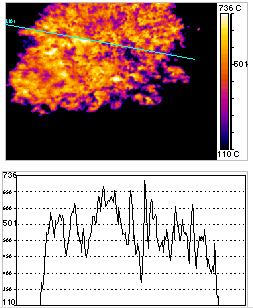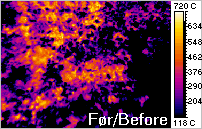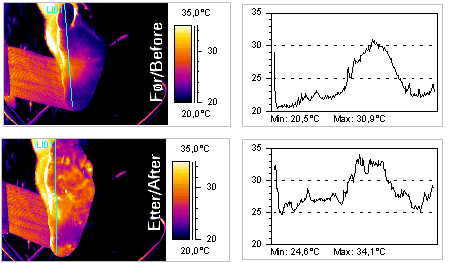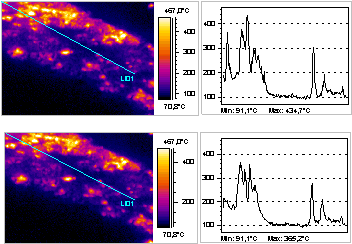 The
line crossing the image indicates a cross section. The graph
underneath indicates this temperature profile.}
The
line crossing the image indicates a cross section. The graph
underneath indicates this temperature profile.}
I had hypothized that walking on the coals would make a sharp, dark footprint on the coals, the would diffuse with time, and I intended to find out how it would diffuse. The reason for this is that you can see a dark footprint in the coal especially if the walk is done at night. Further, I thought the bed was going to cool as a consequence of the walks.
The first image shows the temperature in the bed before the first walk.
 The
line crossing the image indicates a cross section. The graph
underneath indicates this temperature profile.}
The
line crossing the image indicates a cross section. The graph
underneath indicates this temperature profile.}
This image shows clearly that the temperature is very variable, and the bed is very inhomogenous. Earlier measurements of the temperature of beds has to my knowledge been done using pyrometers. With this degree of inhomogenity it seems to me they are of questionable value and validity. The only relevant measure of a beds temperature is an average obtained by taking an infrared picture. We did not compute any such average.
This is particulary glaring as the max and the min value in this plot are next to each other.
 This is an animation showing the temperatures in the bed just before
the walker goes, and just after (that is about 1 minute)
This figure clearly shows the failure of my hypothesis that there
would be a sharp footprint on the coal. Though the image may have been
taken a minute after the walk, there was no significant change in the
temperature in the coal. The dark footprint seen visually is probably
caused because the foot may remove some ashes of light color from the bed.
This is an animation showing the temperatures in the bed just before
the walker goes, and just after (that is about 1 minute)
This figure clearly shows the failure of my hypothesis that there
would be a sharp footprint on the coal. Though the image may have been
taken a minute after the walk, there was no significant change in the
temperature in the coal. The dark footprint seen visually is probably
caused because the foot may remove some ashes of light color from the bed.
The manufacturer of the camera gives the resolution to about 0.1 K. The operator felt it was somewhat larger, but not very much, certainly not an order of magnitude.
We must conclude the energy transport from the coal to the foot is very small.
I didn't expect we could do anything accurate here, but it turned out to work pretty good.
One of the walkers sat in a chair at the end of the bed, putting his leg on a smaller chair. We took a picture of his foot. He walked around the bed, and over and sat down on the chair as fast as he could, without this foot touching the ground. Another picture was taken, less than 20 seconds after the walk (it may have been much less, I don't know). It this time, the coal had cooled somewhat from the first walks, a rough estimate may be that the bed had about 250 degrees centigrades.
 The temperature under the foot before and after a walk. The cyan line
under the foot indicates the cross section that the graphs
indicate
It seems to be a temperature increase of about 4 K. This is not
much. To my knowledge, it is possible to start getting blisters at
about 52 degrees centigrades. This is very far from it.
The temperature under the foot before and after a walk. The cyan line
under the foot indicates the cross section that the graphs
indicate
It seems to be a temperature increase of about 4 K. This is not
much. To my knowledge, it is possible to start getting blisters at
about 52 degrees centigrades. This is very far from it.
Just as expected, the bed cools pretty rapidly. You can feel a pretty intense heat the first ten minutes, it hot for about 25 minutes. After about 35 minutes, the images of figure 4 was taken.
 The bed about 35 minutes after the first walk. There is again
a cyan cross section in the image. This cross section follows a normal
walking path.
It was normal to walk along the black central part of this image, and
as the graph along the cross section shows, it is now around the
boiling point of water. This is not very hot in this case.
The bed about 35 minutes after the first walk. There is again
a cyan cross section in the image. This cross section follows a normal
walking path.
It was normal to walk along the black central part of this image, and
as the graph along the cross section shows, it is now around the
boiling point of water. This is not very hot in this case.
It would be very valuable to find how much heat is removed by the walkers. We can see from figure 4 that it is a lot cooler along the normal walking path, but the cause of this, I must say, is more or less unknown. In section 2.2 we saw there wasn't much of a cooling. There has not been much of an increase of temperature in the foot either. Whether this part cools because of indirect effects, such as compressing coals are also unknown. Nor do we know how much radiates away, or conducted into the ground, etc. What we do know, is that this radiation feels intense in the beginning, and it takes about a quarter of an hour to barbeque a Wiener-sausage (to 70 degrees centigrades)!
I will suggest a method to find the walkers contribution in section 3.2.1.
I attempted standing still for a while about 45 minutes after the first walk. The temperature where I stood was 60-70 degrees centigrades. I stood still for about 45 seconds, and there was no problem.
Actually, there was a 6 year old boy at the farm where we had this walk, and he insisted to try, and he did, and he thought it was great.